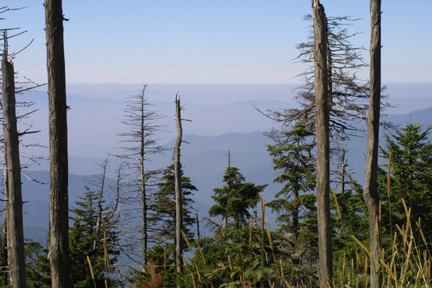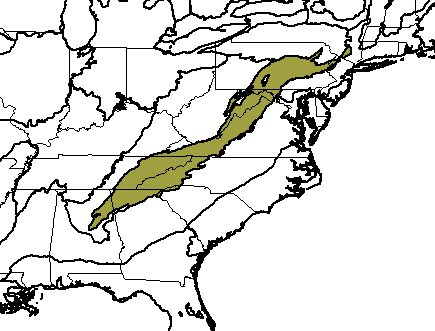
Dead Fraiser firs (Abes fraseri) at Clingman's Dome, Great Smoky Mts. Ntl. Park, east Tennessee (c) 2002 Steven J. Baskauf
Bioimages home (click on an image to enlarge)
view
this page in its intended navigation context
Appalachian/Blue Ridge Forests
(WWF
ecoregion NA0403)

Dead Fraiser firs (Abes fraseri)
at Clingman's Dome, Great Smoky Mts. Ntl. Park, east
Tennessee (c) 2002 Steven J. Baskauf

Source of bioregions data:
Olson, D. M. and
E. Dinerstein. The Global 200: Priority ecoregions for global conservation. (PDF
file) Annals of the Missouri Botanical Garden 89:125-126.
Distinctiveness (1=highest,4=lowest): 1
(globally outstanding)
The second most diverse temperate broadleaf forest on earth, including 158 tree
species, 1400 species of spring-blooming herbaceous plants, and 34 species of
salamanders. Along with the Appalachian Mixed Mesophytic Forests it has the
highest total number of endemic flora and fauna species in North America.
The varying elevation and long-term geological stability has contributed to the
great diversity.*
Conservation Status (1=most endangered, 5=most
intact): 3 (vulnerable)
17% unaltered habitat. A few large blocks of unlogged forest remain in the
Great Smoky Mountains region. Logging has reduced diversity. The dominant
American chestnut has been nearly extirpated by a fungal blight and mature
Fraiser firs have been nearly eliminated from high-elevation forests by an
introduced insect, the balsam wooly adelgid. Air pollution, mineral
extraction, and development threaten the region.*

haze resulting from air pollution, Great Smoky Mts. Ntl. Park, east Tennessee
(c) 2002 Steven J. Baskauf
hires
 salamander
species
salamander
species Liriodendron
tulipifera
Liriodendron
tulipifera Castanea dentata (American chestnut)
Castanea dentata (American chestnut) Picea rubens (red spruce)
Picea rubens (red spruce) Abes fraseri (Fraser fir)
Abes fraseri (Fraser fir) Carya
species
Carya
species Quercus
rubra
Quercus
rubra Quercus
montana (chestnut oak)
Quercus
montana (chestnut oak) Quercus
velutina
Quercus
velutina Robinia
pseudoacacia (black locust)
Robinia
pseudoacacia (black locust) Betula
species
Betula
species Acer
rubrum (red maple)
Acer
rubrum (red maple) Pinus species
Pinus speciesTree species of the Great Smoky Mountains National Park
Associated habitats
In this ecoregion, differences in elevation produce varying habitats.
At higher elevations, habitats typical of more northerly latitudes are found.


cove hardwood forest (left: logged, right: old growth), Cove Hardwood
Nature Trail, Great Smoky Mts. Ntl. Park, east Tennessee (c) 2002 Steven J. Baskauf
hires
hires
Typical woody species:

hemlock forest, Trillium Gap Trail, Great Smoky Mts. Ntl. Park, east
Tennessee (c) 2002 Steven J. Baskauf
hires
Typical woody species:

rhododendron thicket, Great Smoky Mts. Ntl. Park, east Tennessee
(c) 2002 Steven J. Baskauf
hires
Typical woody species: Kalmia latifolia (mountain laurel),
Leucothoe fontanesiana (dog hobble),
Rhododendron catawbiense (Catawba rhododendron),
Rhododendron maximum (rosebay rhododendron)

northern hardwood forest, Great Smoky Mts. Ntl. Park, east Tennessee
(c) 2002 Steven J. Baskauf
hires
Typical woody species:



spruce-fir forest, Clingman's Dome, Great Smoky Mts. Ntl. Park, east
Tennessee (c) 2002 Steven J. Baskauf
hires
hires
hires
Typical woody species: Abes fraseri (Fraser fir), Picea rubens (red spruce), Sorbus
americana (mountain ash)

heath bald, Allegheny Mountains, West
Virginia
(c) 2004
Maurice J. Kaufmann
hires

dry slope, Lehigh Gorge State Park,
Pennsylvania
(c) 2005 Daniel P.
Duran
hires
* Ricketts, T.H., E. Dinerstein, D.M. Olson, C.J. Loucks, et al. (1999) Terrestrial Ecoregions of North America: A Conservation Assessment. World Wildlife Fund - United States and Canada. Island Press, Washington, D.C. pp. 182-186.
Except as noted, images copyright 2002-2004 Steve Baskauf - Terms of use